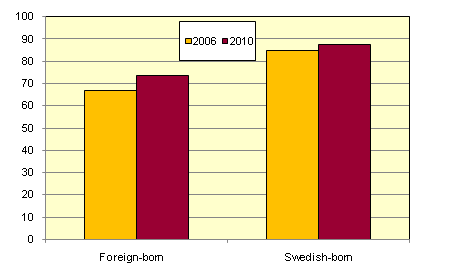General elections, electoral participation survey:
A more equal election turnout
Statistical news from Statistics Sweden 2011-04-14 9.30
Election turnout increased in the 2010 elections. Above all, the proportion of voters increased in groups that normally vote less than others, such as young people and foreign-born persons. Despite this producing a more equal turnout, major differences still remain.
The proportion of those who voted increased in the 2010 Riksdag election by 2.6 percentage points to 84.6 percent. The corresponding increase in county council and municipal council elections was 2.2 percentage points. This means that election turnout has risen two years running.
There are still significant differences between various groups, however. The percentage of voters is lower among young people, single people, low-educated people and the unemployed, while it is higher among middle-aged people, co-habitees, high-educated people and those in work. These differences have been apparent earlier and are still present in the 2010 elections. But the increase in turnout in 2010 was mainly in groups that normally vote less than others, producing a more equal turnout.
In the Riksdag election of 2010, turnout was clearly higher among young people. Among the under-30s, turnout increased by nearly 4 percentage points, compared to a rise of just under 2 percentage points in the 50–64 age group. On the other hand, turnout is still comparatively low among young people.
| Age group | Election year | Change | |
|---|---|---|---|
| 2006 | 2010 | 2006–2010 | |
|
18–29 yrs
|
75.7 | 79.5 | 3.8 |
|
30–49 yrs
|
82.6 | 85.5 | 2.9 |
|
50–64 yrs
|
87.1 | 88.9 | 1.8 |
|
65– yrs
|
80.3 | 83.2 | 2.9 |
|
Total
|
82.0 | 84.6 | 2.6 |
Another group in which election turnout is comparatively low is foreign-born persons. Swedish citizens born outside Sweden vote much less than those born in Sweden, although the difference has also decreased here. In the 2010 Riksdag election, turnout among foreign-born persons rose by almost 7 percentage points to 73 percent. Among those born in Sweden, turnout increased by just under 3 percentage points to 87 percent. Although the difference in turnout between foreign-born and Swedish-born persons has decreased, it is still 14 percentage points.

Low turnout among foreign nationals and Swedish expatriates
The increase in turnout has also been comparatively large in other groups who normally vote less than others. For example, turnout has gone up more among low-educated people and blue-collar workers than among high-educated people and white-collar workers. There are exceptions from the general trend, however. Election turnout did not increased among foreign nationals eligible to vote in county council and municipal council elections. In the 2010 municipal council elections, 36 percent of foreign nationals voted. This is about the same level as in the 2006 election. Swedish expatriates are another group that continues to have low turnout, with only 31 percent of them voting in the 2010 Riksdag election. In relation to the 2006 election, there was no statistically significant difference.
About the survey
Statistics Sweden is today publishing the results of the 2010 electoral participation survey. The survey describes election turnout in various groups in the 2010 elections to the Riksdag, the county councils and municipal councils. The proportion of voters is reported by e.g. sex, age, country of birth, foreign/Swedish background, citizenship, region, civil status, income, level of education, employment status, profession, labour market sector, socioeconomic group (SEI) and employee organisation membership. The survey is a sample survey, which means that there is some uncertainty in the reported figures. This statistical uncertainty is reported in the results in the form of margins of error. The results are presented as tables on the Statistics Sweden website and in the Statistics Sweden Statistical Database, see the information below.
Definitions and explanations
Age pertains to age at the end of the election year.
On 15 May, there will be re-elections to the county council (regional assembly) in Västra Götaland and to the municipal council in Örebro, north-east constituency. The information being published today relates to election turnout on 19 September 2010.
Statistical Database
More information is available in the Statistical Database
Feel free to use the facts from this statistical news but remember to state Source: Statistics Sweden.
